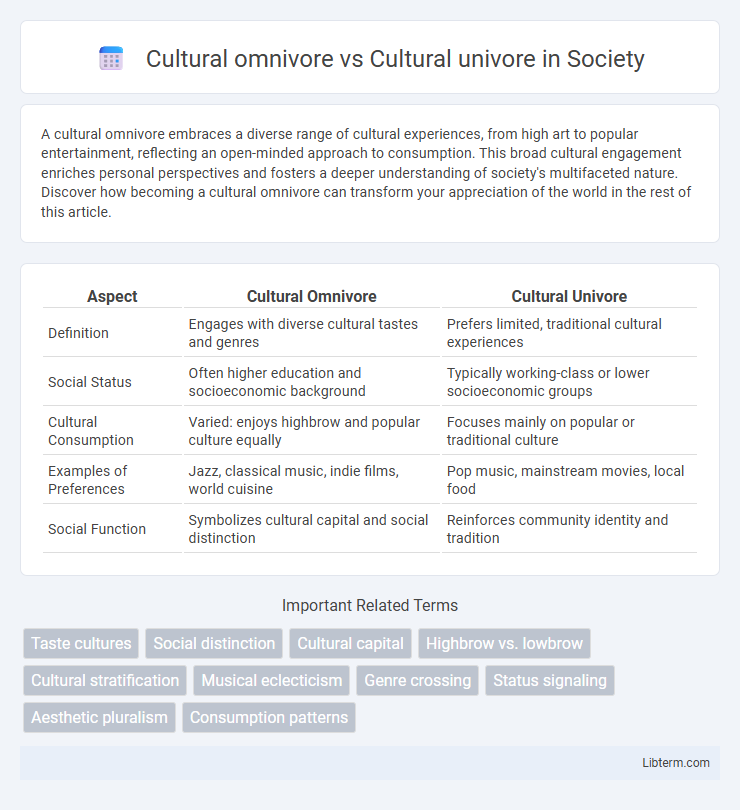A cultural omnivore embraces a diverse range of cultural experiences, from high art to popular entertainment, reflecting an open-minded approach to consumption. This broad cultural engagement enriches personal perspectives and fosters a deeper understanding of society's multifaceted nature. Discover how becoming a cultural omnivore can transform your appreciation of the world in the rest of this article.
Table of Comparison
| Aspect | Cultural Omnivore | Cultural Univore |
|---|---|---|
| Definition | Engages with diverse cultural tastes and genres | Prefers limited, traditional cultural experiences |
| Social Status | Often higher education and socioeconomic background | Typically working-class or lower socioeconomic groups |
| Cultural Consumption | Varied: enjoys highbrow and popular culture equally | Focuses mainly on popular or traditional culture |
| Examples of Preferences | Jazz, classical music, indie films, world cuisine | Pop music, mainstream movies, local food |
| Social Function | Symbolizes cultural capital and social distinction | Reinforces community identity and tradition |
Introduction to Cultural Omnivore and Univore Concepts
Cultural omnivores engage with a diverse range of cultural experiences, from classical music and fine art to popular entertainment, reflecting an inclusive and broad aesthetic taste. In contrast, cultural univores typically consume a narrow spectrum of cultural products, often limited to specific genres or artistic forms, demonstrating a more exclusive cultural preference. These concepts help sociologists understand cultural consumption patterns and how they relate to social identity and status.
Historical Background of Cultural Consumption
The concepts of cultural omnivore and cultural univore emerged from sociological studies in the 1990s, particularly the work by Richard A. Peterson, who identified shifts in cultural consumption patterns linked to social class distinctions. Cultural omnivores exhibit diverse tastes across highbrow, popular, and folk culture, reflecting a broad cultural engagement that contrasts with cultural univores, who prefer restricted, traditional forms, often associated with working-class identities. Historical analysis reveals that these consumption patterns evolved as markers of social status and identity in increasingly pluralistic societies, challenging earlier models that aligned cultural taste strictly with elite exclusivity.
Defining Cultural Omnivores
Cultural omnivores are individuals who engage with a wide range of cultural genres, including both highbrow and popular forms, reflecting diverse tastes across music, art, literature, and cuisine. This contrasts with cultural univores, who prefer a limited scope of cultural experiences, often confined to traditional or elite categories. Studies in cultural sociology highlight that cultural omnivory correlates with higher social status and educational attainment, indicating a broader openness to various cultural expressions.
Characteristics of Cultural Univores
Cultural univores demonstrate a narrow range of cultural consumption, typically engaging with familiar, mainstream art forms and media. They prefer conventional genres, avoiding diversity in cultural experiences and showing limited interest in exploring new or unfamiliar cultural expressions. This pattern often reflects social and economic factors, with univores exhibiting lower cultural capital and less exposure to varied cultural environments.
Socioeconomic Influences on Cultural Preferences
Cultural omnivores, often associated with higher socioeconomic status, exhibit diverse tastes across both highbrow and popular culture, reflecting greater cultural capital and access to varied cultural experiences. In contrast, cultural univores tend to have narrower cultural preferences, typically influenced by limited socioeconomic resources and restricted exposure to diverse cultural forms. Socioeconomic factors such as education, income, and social networks significantly shape whether individuals develop omnivorous or univorous cultural consumption patterns.
Cultural Omnivores in Contemporary Society
Cultural omnivores exhibit diverse tastes across multiple cultural domains, embracing a wide range of music, art, literature, and cuisine that spans from highbrow to popular culture. In contemporary society, this openness reflects increasing social mobility, interconnectedness, and the diminishing rigidity of traditional cultural hierarchies. Research shows cultural omnivores tend to have higher education levels, urban residency, and cosmopolitan lifestyles, highlighting their role in bridging cultural divides and fostering inclusivity.
Impacts of Education on Cultural Tastes
Higher education often broadens cultural tastes, leading individuals to become cultural omnivores who appreciate diverse genres and artistic expressions. In contrast, limited educational exposure tends to reinforce cultural univore preferences, where consumption focuses narrowly on familiar or mainstream cultural forms. Research indicates that educational attainment significantly shapes cultural consumption patterns, fostering openness and inclusivity in cultural experiences.
Cultural Univore Trends in Modern Culture
Cultural univores tend to consume a narrow range of cultural products, often favoring mainstream and traditional genres such as popular TV shows, top-chart music, and widely recognized films. This trend reflects a preference for comfort and familiarity, frequently linked to demographic factors like lower education levels and socioeconomic status. In modern culture, the persistence of cultural univore behavior highlights ongoing social divisions in cultural consumption despite increased access to diverse content through digital platforms.
Implications for Social Stratification
Cultural omnivores exhibit diverse tastes across various cultural domains, reflecting higher social capital and openness linked to elite status, while cultural univores demonstrate limited cultural preferences typically associated with lower social strata. The omnivore-univore distinction informs patterns of social stratification by signaling access to broad cultural resources and symbolic distinctions that reinforce class boundaries. This dynamic influences cultural consumption as both a marker of social identity and a mechanism perpetuating social inequality.
Future Perspectives on Cultural Consumption
Future perspectives on cultural consumption emphasize a shift towards cultural omnivorism, where individuals increasingly explore diverse and eclectic cultural forms, breaking traditional social and class barriers. Digital platforms and globalization enhance access to varied cultural experiences, fostering inclusivity and hybridization in cultural preferences. However, persistent socioeconomic inequalities may influence the extent to which cultural omnivorism is adopted, maintaining some degree of cultural univorism among certain demographics.
Cultural omnivore Infographic

 libterm.com
libterm.com